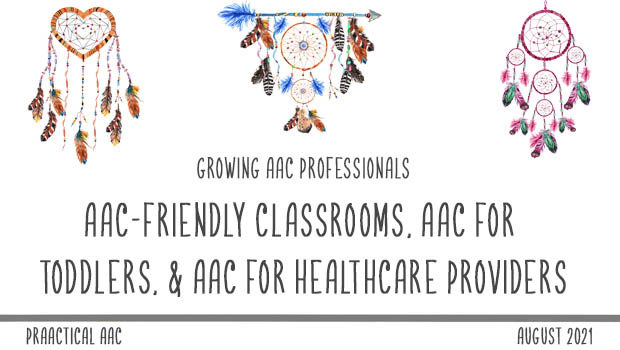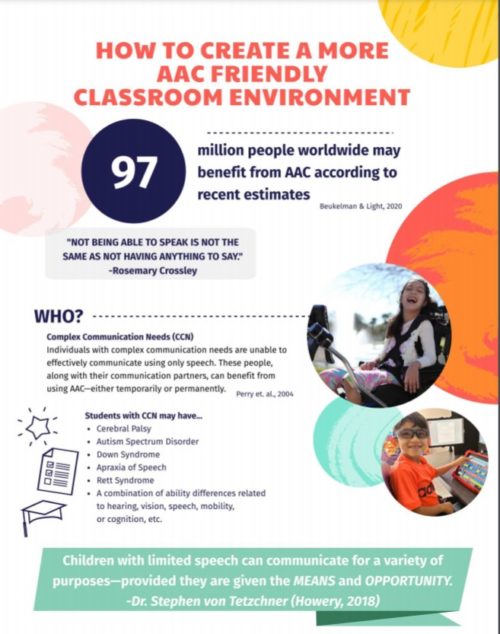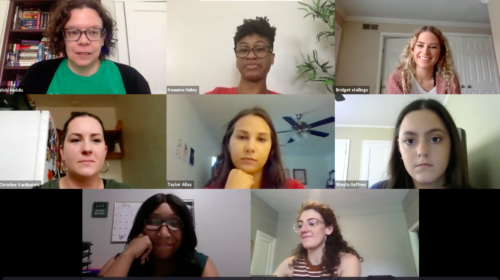Growing AAC Professionals: AAC-friendly Classrooms, AAC for Toddlers, & AAC for Healthcare Providers

As one semester ends and a new one begins, we welcome Vicki Haddix back to these pages to share the work of graduate student SLPs who enroll in her AAC classes. Vicki is an AAC SLP and a Clinical Assistant Professor at the University of Memphis. Today, she shares three student projects on a diverse range of topics.
We invite you to explore the work of Vicki’s students, SLPs-to-be Shayla Gaffney, Lori Davis, and Abbie Warr.
:::::::::::::::::::::::::::::::::::::::::::::::::::::::::::::::::::::::::::::::::::::::::::::::::::::::::::::::::
When I designed the AAC course, I tried to incorporate elements of Universal Design for Learning (UDL) within the class. One of the elements I’m particularly proud of is allowing the students to choose their own final projects, which are worth 50% of their grade. I give them the following guidelines:
Your final project should:
- Collect information from a variety of sources (i.e.: not only a survey or only research articles);
- Ground itself within the field of AAC specifically and SLP generally (this may or may not take the form of a literature review);
- Explicitly state how the information in the project is important to SLPs and/or users of AAC and their families and;
- Be well organized.
I meet with each student, individually or in the pairs that chose to work together, to decide the project. The students check in with me as needed through the rest of the semester, and then present to each other about what they did on the final day of class.
While there is nothing in the guidelines I give them that says their project should be practical and ready to distribute to the AAC community, more and more projects over the years have gone in this direction. Which is great, and I think they deserve a wider audience. I hope PrAACtical AAC readers will agree with me and find these materials useful
First up, Shayla Gaffney is one of many students who have been inspired by Sarah Gregory’s guest appearance on the Talking with Tech podcast with Chris Bugaj and Rachel Madel. They spoke about inclusion and ways to integrate AAC communicators into general education classrooms. Shayla took that information to start and then did a lot more research, which she compiled into this wonderful handout on how to create a more AAC friendly classroom environment. 
Lori Davis knew she would be working in Early Intervention after her graduation and wanted to create a final project that she could use going forward in her career. Lori is family-centered in her practice and prioritized a project that could be helpful to parents just learning about AAC. After considering a number of format options, she ultimately developed this great website with an FAQ, pulling a few great videos, and writing some short blog posts to get started. 
When it came time for Abbie Warr to choose a project, she recalled a blog post by endever* where they described a frustrating interaction at a doctor’s appointment. After brainstorming a few ways to improve customer service, Abbie created a training and made a video on Supporting AAC Users- Training for Healthcare Providers and Support Staff. We’ve already tried it out with the business office staff in our university clinic, and they found it helpful!
Direct Link to Video – https://www.youtube.com/watch?v=gMIk3luIjGg&ab_channel=AbigailWarr
It’s exciting to see the enthusiasm for AAC by these students and other future SLPs at the University of Memphis.

Filed under: Featured Posts, PrAACtical Thinking
This post was written by Carole Zangari

2 Comments
This is such a wonderful initiative by the students! It’s inspiring to see how their projects are directly addressing the real needs of AAC users and those who support them, especially in classrooms and healthcare settings. Shayla’s work on creating AAC-friendly classrooms is so valuable for educators, and Lori’s website will be incredibly helpful for parents just starting their AAC journey. Abbie’s training video for healthcare providers is such a practical and much-needed resource. At iMagnum Healthcare Solutions, we understand the importance of supporting AAC users, and these projects reflect a true commitment to improving AAC integration and accessibility for users across different environments. Great job to all the students involved, and I hope their work continues to make a positive impact!
This is a fantastic initiative! The projects showcase such creativity and thoughtfulness, especially in addressing practical challenges AAC users face in various environments. I particularly love the focus on making classrooms more inclusive, providing resources for parents, and improving healthcare provider training. These kinds of projects can truly make a difference in enhancing communication for AAC users. Kudos to the students and instructors for such impactful work!